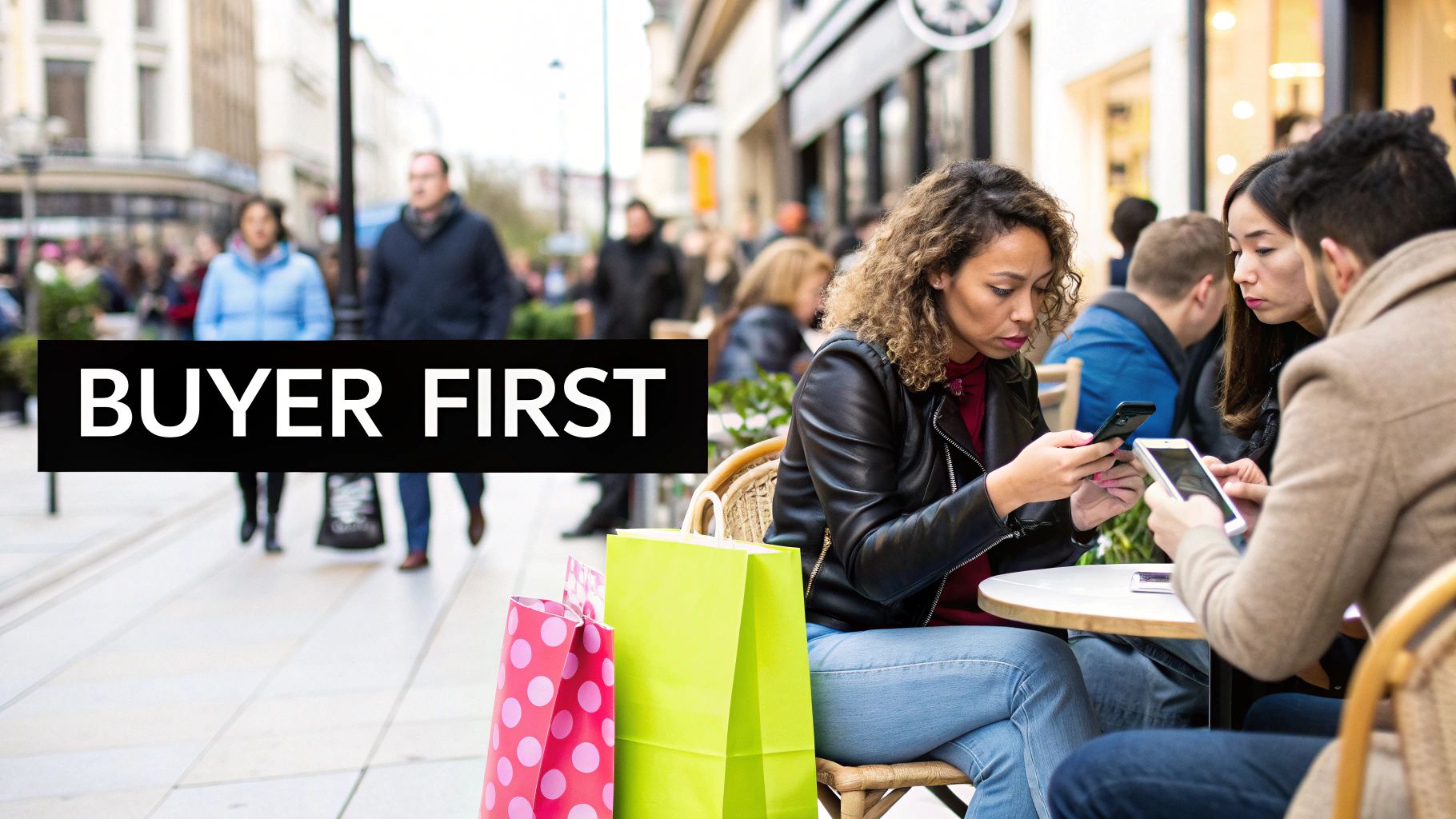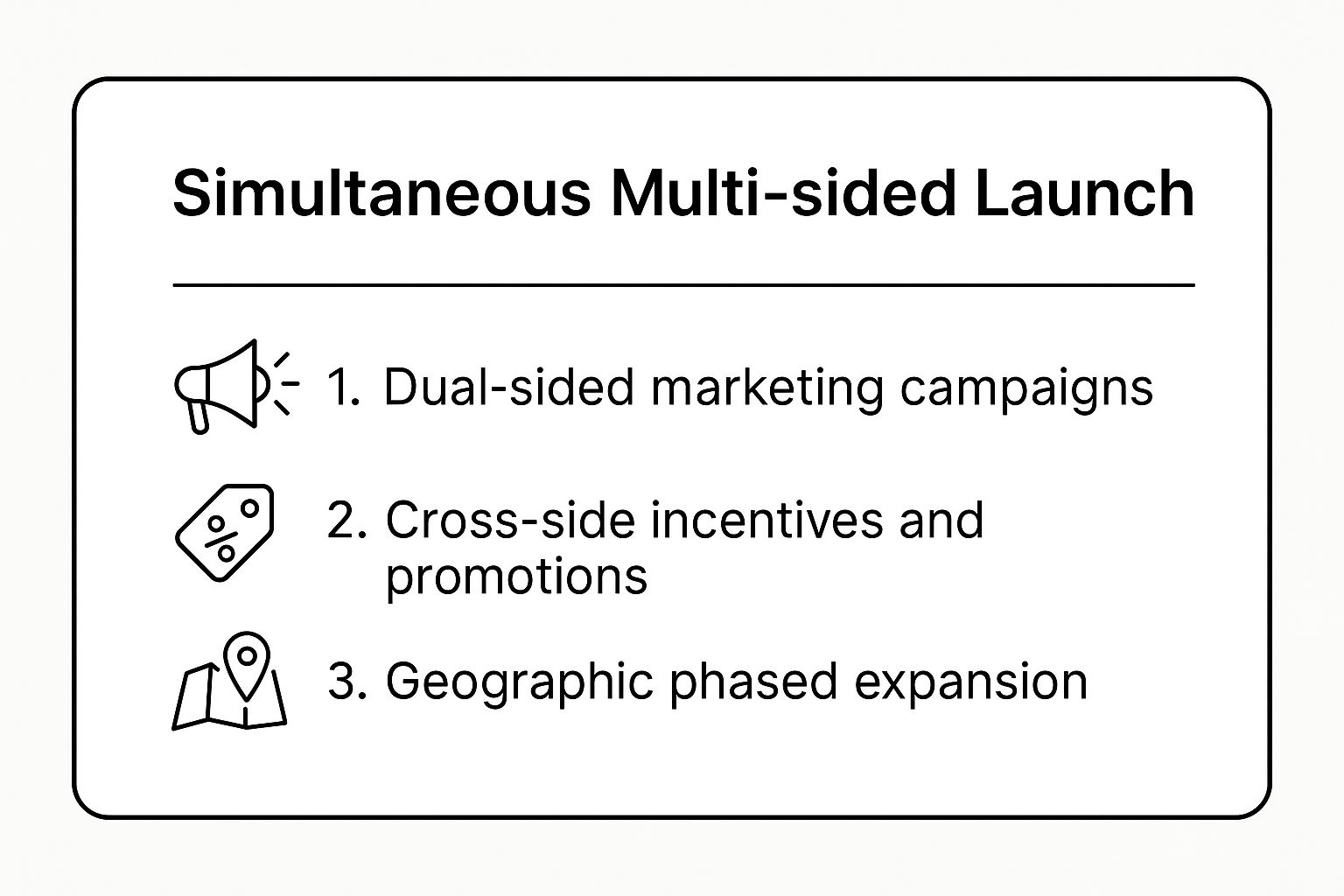Building a successful SaaS marketplace presents a classic chicken-and-egg challenge: how do you attract buyers without sellers, or sellers without buyers? Solving this critical puzzle is the key to achieving liquidity, the point where your platform has enough activity on both sides to become self-sustaining and unlock exponential growth. Many founders get stuck here, but the path to a thriving ecosystem is paved with proven marketplace growth strategies.
This article moves beyond generic advice to provide a tactical playbook. We will break down nine distinct approaches, from focusing on the demand-side first to building a vibrant community that attracts both buyers and sellers organically. Each strategy is detailed with actionable steps and real-world examples from successful marketplaces like Airbnb, Etsy, and Uber, helping you identify the right model for your specific situation.
Forget the theoretical. This is a practical guide designed to help you solve your unique marketplace dilemma and build unstoppable momentum. Understanding these frameworks is the first step toward transforming your platform from an empty digital space into a bustling hub of activity. Let’s dive into the strategies that can ignite your marketplace's growth.
1. Buyer-First (Demand-Side) Growth Strategy
A buyer-first or demand-side growth strategy focuses on attracting a critical mass of buyers before concentrating on seller acquisition. The core principle is simple: suppliers are naturally drawn to platforms where customers are already active and waiting to purchase. By solving the demand side of the chicken-and-egg problem first, you create a powerful incentive for suppliers to join, kickstarting the network effect.

This approach was famously used by pioneers like Uber, which prioritized getting riders on the platform before aggressively recruiting drivers. Similarly, Airbnb first targeted travelers in need of affordable lodging, creating a pool of potential customers that made it attractive for hosts to list their properties.
How to Implement a Buyer-First Strategy
To successfully execute this strategy, you must become an expert in acquiring your target buyers. Building a robust demand pipeline is non-negotiable. For a deeper understanding of this process, exploring effektiva strategier för leadgenerering can provide foundational knowledge for acquiring initial demand.
- Build Detailed Buyer Personas: Go beyond demographics. Understand your buyers' pain points, motivations, and the channels where they spend their time. Use this to tailor your messaging and acquisition efforts.
- Leverage Content and Community: Create valuable content that solves a problem for your target buyers. This could be blog posts, guides, or free tools. Fostering a community around this content can build an initial user base before the supply side is even established.
- Implement Buyer Referral Programs: Encourage your initial buyers to invite others. Offer incentives like discounts or credits to both the referrer and the new user to accelerate growth organically. This is one of the most effective marketplace growth strategies for building initial momentum.
- Focus on a Hyper-Niche: Don't try to appeal to everyone at once. Target a specific, underserved niche to gain traction. Amazon started with books; Facebook started with Harvard students. Dominate a small market first, then expand.
2. Seller-First (Supply-Side) Growth Strategy
A seller-first or supply-side growth strategy reverses the buyer-first model by focusing on attracting a critical mass of high-quality sellers or service providers before marketing to buyers. The core principle here is that an exceptional and diverse inventory is the strongest magnet for attracting customers. When buyers see a rich selection of products or services, they are naturally drawn to the platform, solving the demand side of the chicken-and-egg problem.

This approach was effectively used by Etsy, which first built a vibrant community of unique artisan sellers, creating an exclusive catalog that couldn't be found elsewhere. Similarly, OpenTable focused on getting restaurants to adopt its system before it heavily marketed the platform to diners. This ensured that when users arrived, they had a comprehensive list of restaurants to choose from.
How to Implement a Seller-First Strategy
Executing this strategy requires you to become a partner to your suppliers, providing them with tools and incentives that make your platform indispensable. Building a strong, high-quality supply base is the foundation of your marketplace's value proposition.
- Offer Powerful Seller Tools: Provide suppliers with valuable tools for free that help them manage their business. This could include analytics dashboards, inventory management systems, or booking software. The goal is to make your platform a crucial part of their daily operations.
- Focus on Seller Education and Support: Create resources like guides, webinars, and workshops that teach sellers how to succeed on your platform and in their broader business. Exceptional support makes suppliers feel valued and invested in your marketplace's success.
- Build Strong Seller Communities: Foster a sense of community through forums, events, and networking groups. A connected seller base can share best practices, provide feedback, and become powerful advocates for your platform, making this one of the most durable marketplace growth strategies.
- Implement Attractive Onboarding Incentives: Reduce friction for new sellers by offering free or discounted onboarding, temporary commission-free periods, or marketing co-op funds. These initial perks can be crucial for attracting the first wave of high-quality suppliers.
3. Simultaneous Multi-sided Launch
A simultaneous multi-sided launch strategy tackles the classic chicken-and-egg problem head-on by building both the supply and demand sides of the marketplace at the same time. This approach requires carefully coordinated marketing efforts, targeted incentives, and often a geographically-focused rollout to manage complexity and create density. Instead of waiting for one side to reach critical mass, you generate momentum on both fronts simultaneously.
This is one of the more resource-intensive marketplace growth strategies, but when executed well, it can lead to rapid, defensible moats. Marketplaces like Thumbtack and Rover perfected this model by launching city by city, ensuring that for every new user searching for a service, there was a local provider ready to fulfill their request.
How to Implement a Simultaneous Launch Strategy
Successfully launching both sides at once is a balancing act. It requires robust operational capabilities and a deep understanding of the hyperlocal dynamics that drive both supply and demand. You must attract providers and customers in tandem to create a vibrant, functional local market from day one.
Below, the infographic highlights the core pillars of this synchronized approach, breaking down how to manage dual-sided campaigns, incentives, and expansion.

This visual guide emphasizes that success hinges on integrating your marketing, incentives, and geographic rollout into a single, cohesive plan.
- Focus on Geographic Density: Don't launch nationwide at once. Start with a single city or even a neighborhood. This focus allows you to concentrate your resources to create a liquid market where buyers can quickly find sellers, proving the concept before scaling.
- Create Interconnected Launch Events: Host local events, webinars, or promotions that bring both buyers and sellers together. This creates an initial spark and personal connection to your platform, fostering a sense of community.
- Use Cross-Side Referral Programs: Design referral programs that incentivize both sides. For example, a happy customer could get a credit for referring a new service provider, and a provider could get a bonus for bringing new customers onto the platform.
- Track Leading Indicators for Both Sides: Monitor key metrics like provider sign-ups, customer search queries, and successful first transactions in real-time. This data is crucial for knowing when to adjust your marketing spend or incentives to maintain a healthy balance.
In this video, Thumbtack co-founder Marco Zappacosta discusses the challenges and strategies behind building a local services marketplace, offering valuable insights into the simultaneous launch model.
4. Single-Player Mode Strategy
The single-player mode strategy is a powerful approach that solves the chicken-and-egg problem by providing significant standalone value to one side of the market before the other side even exists. The core idea is to build a product with immediate, single-user utility, which then naturally evolves into a two-sided marketplace as the user base grows. This is one of the most effective marketplace growth strategies for mitigating early-stage risk.
This strategy was pioneered by companies like OpenTable, which initially offered restaurants a valuable reservation management system. Once a critical mass of restaurants was using the software, OpenTable "flipped the switch" to open the consumer-facing booking side. Similarly, HoneyBook began as a business management tool for creative entrepreneurs, only later adding a client marketplace once its user base was established and engaged.
How to Implement a Single-Player Mode Strategy
Executing this strategy requires identifying a compelling standalone value proposition for your initial user segment. The goal is to create a "sticky" product that users love on its own, which becomes the foundation for future network effects.
- Identify Standalone Value: Pinpoint a significant pain point for one side of your future marketplace that can be solved with a software tool. This could be workflow automation, data management, or content creation.
- Build Features That Lead to Marketplace Behavior: Design your single-player tool so that marketplace interactions are a logical next step. For example, a project management tool could naturally evolve to help users find collaborators for those projects.
- Use Freemium Models to Drive Adoption: Offer the core single-player tool for free to attract a large user base quickly. This builds the initial supply or demand side you need before you can successfully launch marketplace features.
- Time the Marketplace Launch Carefully: Don't introduce the two-sided functionality too early. Wait until you have a critical mass of engaged users on the single-player tool to ensure the marketplace launches with sufficient liquidity and value for new participants.
5. Incentivization and Subsidization
An incentivization and subsidization strategy involves using financial stimuli to artificially accelerate supply and demand. This approach is designed to overcome initial inertia and solve the chicken-and-egg problem by temporarily making the platform more attractive than it would be organically. The goal is to spend capital upfront to kickstart powerful network effects that eventually become self-sustaining.
This is one of the most capital-intensive but effective marketplace growth strategies for rapidly scaling in competitive environments. It was famously popularized by ride-sharing and food delivery giants like Uber and DoorDash. They offered significant driver bonuses, rider discounts, and restaurant subsidies to quickly build liquidity on both sides of their marketplaces, effectively "buying" their initial user base and market share.
How to Implement an Incentivization and Subsidization Strategy
Executing this strategy requires careful financial planning and a clear understanding of your unit economics to ensure the investment leads to long-term, profitable users.
- Set Clear Metrics for Graduation: Define the exact conditions under which incentives will be reduced or removed. This could be based on a certain number of transactions per user, a specific level of marketplace liquidity, or a time-based milestone. Without an exit plan, subsidies can become a permanent crutch.
- Focus Incentives on High-Value Segments: Don't subsidize all users equally. Identify the user segments most likely to become long-term, high-frequency participants and concentrate your financial incentives on acquiring and retaining them.
- Use Time-Limited Promotions to Create Urgency: Frame your offers as temporary to encourage immediate action. "50% off your first three rides" or "zero commission for the first 100 sellers" creates urgency and drives faster adoption than a perpetual discount.
- Track Organic vs. Incentivized Activity: Monitor user behavior closely to distinguish between activity driven purely by subsidies and genuine, organic platform usage. This helps you understand when the network effect is beginning to take hold and you can start tapering off incentives. For more creative ways to structure these offers, exploring different referral marketing ideas can provide valuable inspiration for both new and existing users.
6. Vertical-First Expansion
A vertical-first expansion strategy involves concentrating all your resources on dominating a single, specific industry or niche before attempting to broaden your reach. The goal is to become the undisputed leader within one vertical, leveraging deep industry expertise to create a tailored solution that is far superior to any generic, horizontal platform. This establishes a strong foundation and a defensible moat.
This approach builds immense credibility and brand authority. For example, Procore focused exclusively on construction project management, becoming the go-to platform for that industry. Similarly, Faire initially specialized in connecting independent retailers with artisan wholesalers, while Houzz centered its entire ecosystem on home remodeling and design. This intense focus allows for creating features and workflows that deeply resonate with a specific user base.
How to Implement a Vertical-First Strategy
Executing this strategy requires a commitment to becoming a true industry insider. You must go beyond surface-level understanding and embed your platform into the very fabric of the vertical you choose. This is one of the most powerful marketplace growth strategies for building a loyal, long-term user base.
- Choose Verticals with Strong Network Effects: Select an industry where connections between users (e.g., contractors and suppliers, designers and clients) are critical. The more interconnected the users, the stickier your platform will become.
- Develop Deep Industry Expertise: Hire from the industry, attend trade shows, and speak the language of your users. Your product, marketing, and support must reflect a profound understanding of the vertical's unique challenges and workflows.
- Create Vertical-Specific Features: Build tools that solve problems unique to your chosen niche. Generic solutions won't cut it. Procore’s success, for instance, is built on features specifically designed for the complexities of a construction site.
- Build Community Within Your Vertical: Foster a sense of community by creating forums, hosting events, or publishing industry-specific content. This transforms your platform from a simple tool into an essential industry hub.
- Use Vertical Success as a Proof Point: Once you have dominated one vertical, use that success as a powerful case study to gain credibility and momentum when expanding into adjacent markets.
7. Geographic Market-by-Market Expansion
A geographic market-by-market expansion is a disciplined growth strategy where a marketplace concentrates all its resources on achieving liquidity and dominance in one specific geographic area before moving to the next. The goal is to build a strong, defensible local network effect, creating a playbook that can be replicated and adapted for subsequent market entries. This methodical approach ensures sustainable growth by preventing resources from being spread too thin across multiple fronts.
This strategy was the cornerstone of Uber's global domination, as the company launched and scaled its operations city by city. Similarly, food delivery services like Deliveroo and ride-hailing platforms like Gojek used this tactic to systematically conquer cities and regions across Europe and Southeast Asia, respectively. By proving the model in one location, they created a powerful template for rapid, yet controlled, international expansion.
How to Implement a Geographic Expansion Strategy
Executing this strategy requires deep local market understanding and operational excellence. It's a highly effective way to scale, but each new market presents unique challenges. This approach is one of the most powerful marketplace growth strategies for businesses with location-dependent services.
- Choose Initial Markets Wisely: Prioritize markets with favorable conditions, such as high population density, supportive regulatory environments, and a clear need for your service. Analyze demographics and local competition to identify the path of least resistance.
- Build Local Teams and Partnerships: Empower a local team with the autonomy to adapt your strategy to cultural nuances. Forge partnerships with local businesses, influencers, or organizations to accelerate trust and user acquisition on both the supply and demand sides.
- Adapt Product for Local Preferences: One size rarely fits all. Be prepared to modify your product, pricing, and payment methods to meet local expectations. Gojek, for example, expanded beyond ride-hailing to include payments and other services tailored to Southeast Asian user needs.
- Achieve Liquidity Before Expanding: The core principle of this strategy is to win one market before moving on. Focus intently on reaching a critical mass of buyers and sellers to ensure the marketplace is self-sustaining. Only after achieving this should you divert resources to the next target city or region.
8. Content and Community-Driven Growth
A content and community-driven growth strategy leverages high-value content and user interaction to attract and retain an audience before monetizing through marketplace transactions. The core principle is to build an engaged community by providing information, education, and peer-to-peer connections first. Once you become the trusted hub for a specific interest or problem, introducing a transactional marketplace becomes a natural extension of the value you already provide.

This approach was expertly executed by Houzz, which created a massive community around home design photos and articles before connecting homeowners with professionals. Similarly, Yelp built its platform on user-generated reviews, creating a go-to resource that later became a powerful local business marketplace. Reddit also exemplifies this, fostering countless niche communities before introducing advertising and other marketplace features. These platforms prove that building a loyal audience first is one of the most sustainable marketplace growth strategies.
How to Implement a Content and Community-Driven Strategy
Success with this strategy requires becoming a destination for information and connection, not just transactions. As part of this broader approach, it is vital to develop an effective content marketing strategy to systematically attract and engage your target users. To learn more about the practical steps involved, discover how to build a thriving online community from scratch.
- Create Content That Solves Real User Problems: Focus on creating high-quality, actionable content like guides, tutorials, and case studies that directly address your audience's pain points. This builds trust and authority.
- Actively but Thoughtfully Moderate the Community: A healthy community requires moderation to prevent spam and foster positive interactions. Establish clear guidelines and empower community managers or trusted members to maintain a welcoming environment.
- Gamify Contribution and Engagement: Encourage participation by rewarding users for contributing content, answering questions, or sharing their experiences. Badges, leaderboards, and user levels can turn passive consumers into active contributors.
- Build Clear Paths from Content to Commerce: Don't let your marketplace feel like an afterthought. Seamlessly integrate transactional opportunities within your content and community spaces, such as linking products in a blog post or allowing service providers to answer questions in a forum.
9. Partnership and Integration Strategy
A partnership and integration strategy involves leveraging strategic alliances and API connections to tap into existing user bases and distribution channels. Instead of building an audience from scratch, this approach allows your marketplace to "plug into" established ecosystems, significantly reducing the cost and effort of organic user acquisition. It’s about creating symbiotic relationships where your platform adds value to a partner’s service, and in return, you gain access to their customers.
This powerful strategy is exemplified by platforms like Shopify, which built an entire app store ecosystem, allowing third-party developers to create tools that enhance its core e-commerce platform. Similarly, Stripe's success was accelerated by its seamless payment integrations with countless software tools, making it the default choice for developers and businesses already using those partner platforms.
How to Implement a Partnership and Integration Strategy
Executing this strategy requires a focus on mutual benefit and technical excellence. Your goal is to make it incredibly easy for partners to integrate and see immediate value. This is one of the most scalable marketplace growth strategies, as each new partner can unlock a new stream of users.
- Identify Partners with Aligned Incentives: Look for non-competing companies that serve the same customer profile. The ideal partner's product becomes more valuable when integrated with your marketplace.
- Build a Scalable Integration Process: Develop a robust, well-documented API and provide strong developer support. The easier it is for partners to connect to your platform, the more integrations you will attract.
- Create Mutual Value: Ensure the partnership benefits everyone: you, your partner, and the end-user. This could be through revenue sharing, co-marketing, or providing a more seamless user experience. Many successful integrations function like a well-oiled affiliate program. For a deeper look, you can learn more about designing a SaaS affiliate program to structure these relationships effectively.
- Define Clear Partnership Metrics: Establish and track key performance indicators (KPIs) from the start. Monitor metrics like referral traffic, new user sign-ups from partner channels, and the adoption rate of the integration to measure success and optimize your efforts.
Marketplace Growth Strategies Comparison
| Strategy | Implementation Complexity 🔄 | Resource Requirements ⚡ | Expected Outcomes 📊 | Ideal Use Cases 💡 | Key Advantages ⭐ |
|---|---|---|---|---|---|
| Buyer-First (Demand-Side) Growth Strategy | High 🔄🔄 | High ⚡⚡ | Strong buyer base, natural seller pull 📊📊 | Marketplaces prioritizing buyer acquisition first | Easier scaling post buyer base; strong supplier leverage ⭐ |
| Seller-First (Supply-Side) Growth Strategy | Medium-High 🔄🔄 | Medium-High ⚡⚡ | Quality supply, attractive inventory 📊 | Platforms needing supplier quality control first | Strong supplier relationships; better inventory depth ⭐ |
| Simultaneous Multi-sided Launch | Very High 🔄🔄🔄 | Very High ⚡⚡⚡ | Rapid liquidity and balanced network 📊📊📊 | Marketplaces targeting simultaneous supply & demand | Balanced growth; efficient marketing; fast liquidity ⭐ |
| Single-Player Mode Strategy | Medium 🔄 | Medium ⚡ | Organic user base, immediate value 📊 | Platforms providing standalone value before full launch | Eliminates chicken-and-egg; lower acquisition costs ⭐ |
| Incentivization and Subsidization | Medium 🔄🔄 | High ⚡⚡ | Fast user growth, quick market penetration 📊📊 | Expansion phases needing rapid user adoption | Rapid acquisition; ability to compete aggressively ⭐ |
| Vertical-First Expansion | Medium 🔄 | Medium ⚡ | Deep market penetration, niche leadership 📊 | Specialized/niche-focused marketplaces | Higher LTV; strong moats; better customer understanding ⭐ |
| Geographic Market-by-Market Expansion | Medium-High 🔄🔄 | Medium-High ⚡⚡ | Strong local dominance, measured growth 📊 | Platforms expanding systematically by region | Strong local network effects; optimized resource use ⭐ |
| Content and Community-Driven Growth | Medium 🔄 | Low-Medium ⚡ | High engagement and organic growth 📊 | Community-based or content-rich platforms | Low acquisition cost; strong loyalty; organic growth ⭐ |
| Partnership and Integration Strategy | Medium 🔄 | Medium ⚡ | Access to established users, faster validation 📊 | SaaS, ecosystems, or platforms leveraging integrations | Reduced acquisition cost; shared resources; scalability ⭐ |
Choosing Your Engine: Which Growth Strategy is Right for You?
Navigating the complex journey of building a thriving digital marketplace requires more than just a great idea; it demands a deliberate and adaptable approach to growth. We've explored a powerful arsenal of marketplace growth strategies, from focusing on the buyer-first or seller-first models to executing a simultaneous multi-sided launch. Each framework, whether it's the ingenious Single-Player Mode, a hyper-focused Vertical-First Expansion, or a community-driven content engine, offers a unique path to solving the foundational chicken-and-egg problem.
The most critical takeaway is that these strategies are not mutually exclusive. The true art of scaling lies in recognizing that the most effective approach is often a hybrid, a dynamic blend tailored to your specific market, product, and growth stage. Your initial strategy is merely a starting point, not a permanent blueprint. Success is found in the ability to layer and sequence these tactics as your marketplace evolves.
Synthesizing Your Growth Flywheel
Think of these strategies as building blocks for your platform's growth engine. A common and highly effective sequence might look like this:
- Phase 1: Initial Traction. Start with a Vertical-First strategy to deeply penetrate a niche market. Combine this with a Single-Player Mode to provide immediate value to your initial supply-side users, making your platform useful even before significant demand arrives.
- Phase 2: Igniting Liquidity. Introduce strategic Incentivization and Subsidization to attract the demand side. This could involve offering discounts to early buyers or reduced commission fees for pioneering sellers, creating the initial spark of transactions.
- Phase 3: Scaling and Expansion. Once you achieve liquidity in your first vertical or geographic area, leverage Partnership and Integration strategies to tap into existing user bases. Simultaneously, build a strong Community and Content loop to create a moat and foster organic, long-term growth.
This layered approach transforms disparate tactics into a cohesive, self-reinforcing flywheel. By understanding how to pivot from one strategy to the next, you can maintain momentum and avoid the plateaus that stall so many promising marketplaces.
Your Actionable Next Steps
The journey from concept to a liquid, self-sustaining marketplace is a marathon of strategic execution and relentless iteration. To move forward, focus on these immediate actions:
- Diagnose Your Stage: Honestly assess where your marketplace is right now. Are you pre-launch, struggling with initial traction, or ready to scale? Your current reality dictates your next strategic move.
- Select Your Primary Engine: Choose the single strategy from this list that best addresses your most immediate challenge. Don't try to do everything at once; focus your resources on executing one core strategy exceptionally well.
- Define and Measure KPIs: For your chosen strategy, establish clear Key Performance Indicators. If you're using a Single-Player Mode, track engagement and utility for that single user. If you're subsidizing, measure the cost of acquiring a transaction and the retention rate of those users.
Ultimately, mastering these marketplace growth strategies is about building a resilient, adaptable system. It's about having the right tool for every stage of the journey and knowing when to use it. The path is challenging, but by applying these proven frameworks, you are equipping your platform with the engine it needs to not just survive, but to thrive and dominate its niche.
Ready to turn your users into a powerful acquisition channel? Refgrow makes it effortless to launch and manage an embedded referral program for your marketplace. With just a single line of code, you can build a native growth loop that incentivizes both buyers and sellers to spread the word, accelerating your journey to liquidity. Learn more and get started at Refgrow.com.

